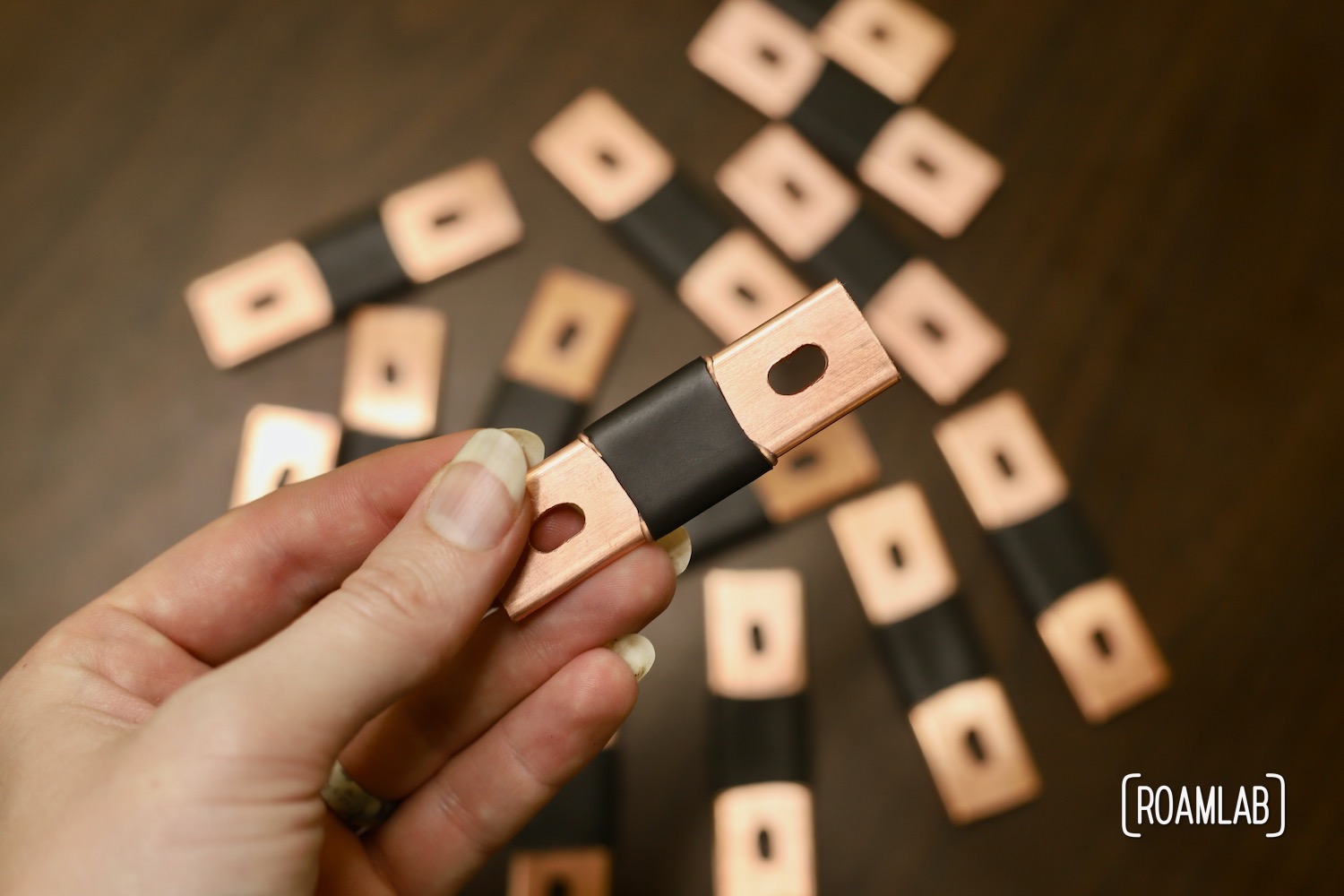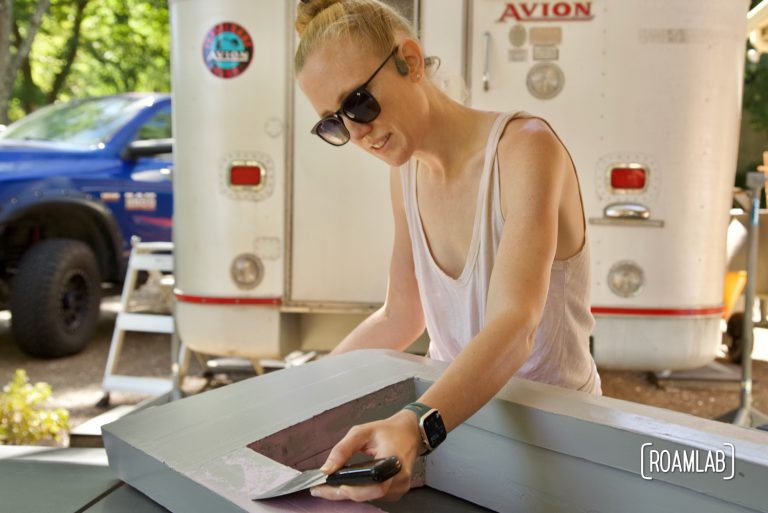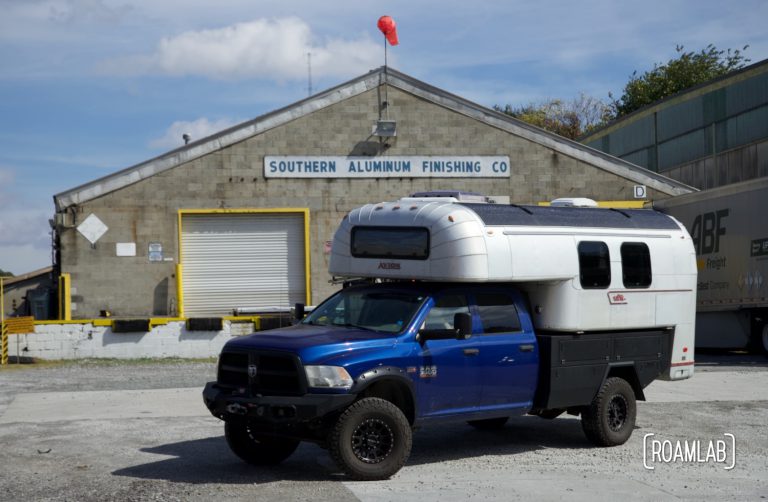Bus bars (busbars) are short strips of conductive metal for high current electric connections. While our renovation of a 1970 Avion truck camper generally deals in low current demands, we are building a DIY lithium battery to power the system. To meet the high current requirements of the connections between the lithium battery cells, we are diving into bus bars: what are they, and how do we make our own? Earlier, we covered the basics of bus bars in our Understanding Bus Bars post. Now, we take on the question of what materials make optimal bus bars and why.
Materials To Use
The key to making a bus bar is conductivity. The goal of a bus bar is to maximize the efficiency of a connection by minimizing any resistance. In the rest of the camper, we will be dealing with relatively small amperages that only call for thin gauge wires. In contrast, the bus bars are handling some of the highest amperages of the whole system. A low conductivity material can limit the efficiency of the battery. So, we want a conductor that can let those amps flow. Popular metals include copper, brass, and aluminum. So we will dig into each.
Copper Bus Bars
Copper deserves its reputation as the go-to conductor for electrical circuits. Copper has remarkably high electrical conductivity, low resistance, and impressive tensile strength when molding it into the desired form. It is a standard metal conductor.
Copper bus bars come in a variety of forms. Copper quickly corrodes when exposed to air. Therefore, many bus bars have a thin layer of non-corrosive material around them, such as tin. Coating copper is particularly common in corrosive environments, such as the ocean. So you’ll often see tinned copper as a marine-grade connector.
Arguably, copper’s most significant downside is the price. Copper is a commodity for many purposes and not the most economical solution. As a result of this and some other notable features, there are other contenders for conductive materials.
Brass Bus Bars
Brass benefits from the presence of copper to aid in its conductivity but the combination of other metals makes it far more sturdy and less malleable. This is why a lot of bolts and other threaded components in electrical systems are made of brass. But its use as a bus bar is less common.
Aluminum Bus Bars
Aluminum usually isn’t the first thing that comes to mind when considering electrical connections. And yet its remarkable heat dissipation, lightweight, and affordability have made it a serious contender.
Not only can aluminum efficiently conduct electrical current, but it is also very light compared to other materials. Inch for inch, aluminum is not as conductive as copper. An aluminum bus bar must be thicker than its copper counterpart to achieve the same amount of conductivity. Nevertheless, aluminum is significantly lighter than copper. So, when correcting for weight, aluminum is far more conductive than copper.
Arguably its crowning feature is aluminum’s remarkable heat dissipation. We have seen aluminum’s outstanding ability to conduct and dissipate heat in our camper, where we have been working hard to insulate the interior. Thick bars of aluminum become effective thermal bridges between extreme temperatures. In this case, the aluminum can help keep a heavily loaded circuit at more manageable temperatures by dissipating the heat generated by the electrical resistance.
Unfortunately, aluminum’s relationship with heat is a mixed one. Aluminum will expand and contract with fluctuations in temperature, which can undermind the reliability of electrical connections. So critical connections (like hooking up battery cells) may need particular contingencies.
One last note to keep in mind is the alloy used. 6106 aluminum is highly conductive and the optimal chemistry for am electrical connection. Fortunately, this is a standard alloy found at most aluminum retailers.
Overall, aluminum is an impressive choice. Despite having to buy more of it to achieve the same conductivity, aluminum is comparatively light on the wallet compared to copper, and the price is much more constant and less prone to surprising spikes.
Our Choice
We finally choose to order copper no. 110. While we delight in any excuse to use aluminum, we opt for the better-documented material for this crucial matter. As it stands, I am perfectly happy with our decision.







Hi Lexi, Thanks for the tip. I’m looking for bus bars now myself. Can you tell me a bit about the small bolts/nuts you used for mechanical fastening? Looks like brass to me . . . ? Did you look at the different possible materials for mechanical fastening and the possible reactions over time with the 110 copper buses?
Thanks!
Hi Matt! Yes, we decided to use brass bolts. We did consider some alternatives but considered brass to still be the optimal balance between conductivity and strength. But we certainly will be keeping an eye on the batteries to see how they wear over time.
Nickel plated brass makes a nice bus bar.
Is there a reason for using short busbars instead of one long busbar for the positive and one for the negative. posts?
Hi Scott!
Yes, there is a reason, though it may not apply to whatever project you may have in mind. One long positive bus bar and one long negative bus bar could work for a parallel connection. But our final arrangement will be in serial. With our short bars, we can demonstrate both parallel and serial connections as we progress in this build.